The Rise of the Creative Shopper

The Rise of the Creative Shopper
Consumer climate meets ‘cluster crisis’. Julia Zimmermann reveals how shoppers are adjusting to current circumstances and how brands can best react accordingly.
Covid, war, climate change, the energy crisis, inflation – we are not just in the midst of one crisis, but facing many different ones, all happening at once. These so-called ‘cluster crises’ are having a profound effect on society and the daily lives of everyone, such as has not been seen for centuries, not only in the form of sacrifices imposed on our personal lifestyle, but also in removing the certainty that we once had. This increased uncertainty has meant that we are no longer as confident as we used to be that everything will be infinitely available and that we can live our lives without constraints.
Consequently, the GfK Consumer Confidence Index dropped to a record low of -42.5 points in October 2022. Evidently, if we observe current consumer behaviour, the effects of the previous crisis should be considered, together with inflation and general uncertainty about future developments. After the alleged levelling-off effect of the threat of Covid, consumers want to make up for lost time and ‘get their lives back’ to compensate for the restrictions of the previous two years. For example, a good many will want to travel a lot to catch up on all the trips they missed these past years. However, according to GfK studies, it is expected that spending, particularly on long-distance journeys, will drop in the coming year, as will the frequency of travel.
Moreover, around a quarter of consumers are already postponing their bigger purchases to ‘better times’, while others are liquidating savings to be able to pay bills. Meanwhile, many consequences of the current situation are not yet making themselves felt. We will not see the mounting energy costs on our bills until next year; it is only then that the capital goods industry, for instance, will peak.
Nevertheless, if we look at consumer behaviour more closely, it becomes evident that individual values are not being thrown overboard, despite the price increases. On the contrary, consumers are becoming smart shoppers who orientate their behaviour very markedly towards their individual values. They pay even more attention to the products they can save money on, and the products where a more expensive brand is worth the price. What is driving consumers is not a ‘cheap is cool’ mentality, but rather a mixture of pride in austerity and conscious consumption.
Therefore, sustainability, socio-economic responsibility, and attitude are still important themes, alongside pleasure, in finding a balance during times of crisis and ‘getting one's life back’ after the time of Covid. Sustainability has already become the ‘new normal’, especially for the younger generations. This and the current pressure to change during the crisis also forces people to sample new lifestyles: "Why not try a vegan or vegetarian product – meat is too expensive anyway and the alternatives are healthier and more sustainable?" Furthermore, the producers of retail brands have realised this and are offering the appropriate products.
However, it is no longer enough for a brand to be either merely functional or merely sustainable: it must be both, but functionality is the baseline. Additional values need to be created for consumers, using emotions, benefit to society, or purpose statements. A value must justify the decision to buy a higher priced brand, so that it does not seem like there is any substitute. Here it is very important to have a thorough knowledge of one's target group: their ideas, values, needs, and daily reality, and then to respond in a carefully tailored manner. Successful brands base their communication on demand and communicate efficiently with their consumers. Here, one should invest in always-on communication, digitalisation and automation models, in order to increase efficiency.
Brands are also expected to communicate regularly with their consumers during the crisis, serving as a beacon and generating confidence through transparency, for instance, by being transparent as to why a product is more expensive or the packaging is now reduced.
What is currently taking place is a wake-up call for brands. In this complexity of price rises and value shifts, brand owners must also develop new strategies, implementing customer centricity with real consistency. More than ever, the brand management of customers must be well thought out and experienced in real life. This does not stop at communication, but also means questioning one's own business model and strategic direction, using the potential of the ‘everything-as -a-service’ model and presenting a compelling case that the brand is on the side of the consumer.
Author: Julia Zimmermann, General Manager at the Serviceplan Consulting Group